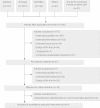A systematic review and meta-analysis of acute stroke unit care: what's beyond the statistical significance?
- PMID: 24164771
- PMCID: PMC4231396
- DOI: 10.1186/1471-2288-13-132
A systematic review and meta-analysis of acute stroke unit care: what's beyond the statistical significance?
Abstract
Background: The benefits of stroke unit care in terms of reducing death, dependency and institutional care were demonstrated in a 2009 Cochrane review carried out by the Stroke Unit Trialists' Collaboration.
Methods: As requested by the Belgian health authorities, a systematic review and meta-analysis of the effect of acute stroke units was performed. Clinical trials mentioned in the original Cochrane review were included. In addition, an electronic database search on Medline, Embase, the Cochrane Central Register of Controlled Trials, and Physiotherapy Evidence Database (PEDro) was conducted to identify trials published since 2006. Trials investigating acute stroke units compared to alternative care were eligible for inclusion. Study quality was appraised according to the criteria recommended by Scottish Intercollegiate Guidelines Network (SIGN) and the GRADE system. In the meta-analysis, dichotomous outcomes were estimated by calculating odds ratios (OR) and continuous outcomes were estimated by calculating standardized mean differences. The weight of a study was calculated based on inverse variance.
Results: Evidence from eight trials comparing acute stroke unit and conventional care (general medical ward) were retained for the main synthesis and analysis. The findings from this study were broadly in line with the original Cochrane review: acute stroke units can improve survival and independency, as well as reduce the chance of hospitalization and the length of inpatient stay. The improvement with stroke unit care on mortality was less conclusive and only reached borderline level of significance (OR 0.84, 95% CI 0.70 to 1.00, P = 0.05). This improvement became statistically non-significant (OR 0.87, 95% CI 0.74 to 1.03, P = 0.12) when data from two unpublished trials (Goteborg-Ostra and Svendborg) were added to the analysis. After further also adding two additional trials (Beijing, Stockholm) with very short observation periods (until discharge), the difference between acute stroke units and general medical wards on death remained statistically non-significant (OR 0.86, 95% CI 0.74 to 1.01, P = 0.06). Furthermore, based on figures reported by the clinical trials included in this study, a slightly higher proportion of patients became dependent after receiving care in stroke units than those treated in general medical wards - although the difference was not statistically significant. This result could have an impact on the future demand for healthcare services for individuals that survive a stroke but became dependent on their care-givers.
Conclusions: These findings demonstrate that a well-conducted meta-analysis can produce results that can be of value to policymakers but the choice of inclusion/exclusion criteria and outcomes in this context needs careful consideration. The financing of interventions such as stroke units that increase independency and reduce inpatient stays are worthwhile in a context of an ageing population with increasing care needs. One limitation of this study was the selection of trials published in only four languages: English, French, Dutch and German. This choice was pragmatic in the context of this study, where the objective was to support health authorities in their decision processes.
Figures




References
-
- Mackey J, Mensah G. The Atlas of Heart Disease and Stroke. http://apps.who.int/bookorders/anglais/detart1.jsp?sesslan=1&codlan=1&co.... 2004. Ref Type: Electronic Citation.
-
- Langhorne P, Dennis M. Stroke units: an evidence based approach. London: BMJ Books; 1998.
-
- Canadian Stroke Strategy. Canadian Best Practice Recommedation for Stroke Care. Update 2010. http://www.strokebestpractices.ca/wp-content/uploads/2011/04/2010BPR_ENG.... 8-12-2012. Ref Type: Electronic Citation.
-
- Thijs V, Peeters A, Dewindt A, Hemelsoet D, De KN, Laloux P. et al.Organisation of inhospital acute stroke care and minimum criteria for stroke care units. Recommendations of the Belgian Stroke Council. Acta Neurol Belg. 2009;109:247–251. - PubMed
Publication types
MeSH terms
LinkOut - more resources
Full Text Sources
Other Literature Sources
Medical
Research Materials

